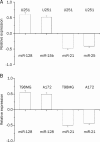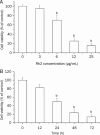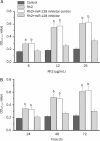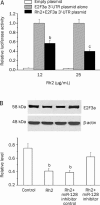Ginsenoside Rh2 inhibits glioma cell proliferation by targeting microRNA-128
- PMID: 21372826
- PMCID: PMC4002775
- DOI: 10.1038/aps.2010.220
Ginsenoside Rh2 inhibits glioma cell proliferation by targeting microRNA-128
Abstract
Aim: To examine the influence of ginsenoside Rh2 (Rh2), a triterpene saponin extracted from the traditional medicinal plant ginseng, on the expression of miRNAs in human glioma cells.
Methods: The expression profile of miRNA (miR) was analyzed in human U251, T98MG and A172 glioma cells using a miRNA array and quantitative real-time PCR. Cell viability was assessed using a colorimetric assay (cell counting kit-8). Transfection of miR-128 was performed using Lipofectamine 2000. Caspase 3 activity was determined using a caspase colorimetric assay kit. Apoptosis was assessed using annexin V and propidium iodide staining. Protein expression was determined with Western blot analysis. miRNA-128 targeting activity was measured using a luciferase reporter assay.
Results: In U251 cells treated with Rh2 (12 μg/mL), 14 of 452 human miRNAs were up-regulated and 12 were down-regulated as detected with the miRNA array assay. The up-regulation of miR-128 by Rh2 was further verified in human U251, T98MG and A172 cells using quantitative real-time PCR. In U251 cells, transfection of a miR-128 inhibitor (50 nmol/L) prevented the overexpression of miR-128 by Rh2, and significantly blunted Rh2-induced cytotoxicity, apoptosis, caspase 3 activation, transcriptional activation of E2F3a, a miR-128 target gene, as well as E2F3a protein expression.
Conclusion: The anti-proliferative effect of Rh2 in human glioma cells was mediated in part through up-regulation of miRNA-128 expression.
Figures









Similar articles
-
MiR-210 up-regulation inhibits proliferation and induces apoptosis in glioma cells by targeting SIN3A.Med Sci Monit. 2014 Dec 7;20:2571-7. doi: 10.12659/MSM.892994. Med Sci Monit. 2014. PMID: 25481483 Free PMC article.
-
Ginsenoside Rh2 inhibits proliferation and migration of medulloblastoma Daoy by down-regulation of microRNA-31.J Cell Biochem. 2018 Aug;119(8):6527-6534. doi: 10.1002/jcb.26716. Epub 2018 Apr 19. J Cell Biochem. 2018. Retraction in: J Cell Biochem. 2021 Nov;122 Suppl 1:S18. doi: 10.1002/jcb.29977. PMID: 29377269 Retracted.
-
MicroRNA-29b promotes cell sensitivity to Temozolomide by targeting STAT3 in glioma.Eur Rev Med Pharmacol Sci. 2020 Feb;24(4):1922-1931. doi: 10.26355/eurrev_202002_20370. Eur Rev Med Pharmacol Sci. 2020. PMID: 32141561
-
Anticancer property of ginsenoside Rh2 from ginseng.Eur J Med Chem. 2020 Oct 1;203:112627. doi: 10.1016/j.ejmech.2020.112627. Epub 2020 Jul 13. Eur J Med Chem. 2020. PMID: 32702586 Review.
-
Ginsenoside Rh2: A shining and potential natural product in the treatment of human nonmalignant and malignant diseases in the near future.Phytomedicine. 2023 Sep;118:154938. doi: 10.1016/j.phymed.2023.154938. Epub 2023 Jun 20. Phytomedicine. 2023. PMID: 37406390 Review.
Cited by
-
A New Frontier in Studying Dietary Phytochemicals in Cancer and in Health: Metabolic and Epigenetic Reprogramming.Prev Nutr Food Sci. 2022 Dec 31;27(4):335-346. doi: 10.3746/pnf.2022.27.4.335. Prev Nutr Food Sci. 2022. PMID: 36721757 Free PMC article. Review.
-
The temozolomide derivative 2T-P400 inhibits glioma growth via administration route of intravenous injection.J Neurooncol. 2014 Jan;116(1):25-30. doi: 10.1007/s11060-013-1255-7. Epub 2013 Sep 25. J Neurooncol. 2014. PMID: 24065569
-
Cucurbitacin B Inhibits the Proliferation of WPMY-1 Cells and HPRF Cells via the p53/MDM2 Axis.Int J Mol Sci. 2024 Aug 28;25(17):9333. doi: 10.3390/ijms25179333. Int J Mol Sci. 2024. PMID: 39273281 Free PMC article.
-
Anticancer Activities of Protopanaxadiol- and Protopanaxatriol-Type Ginsenosides and Their Metabolites.Evid Based Complement Alternat Med. 2016;2016:5738694. doi: 10.1155/2016/5738694. Epub 2016 Jun 30. Evid Based Complement Alternat Med. 2016. PMID: 27446225 Free PMC article. Review.
-
MicroRNA in Human Glioma.Cancers (Basel). 2013 Oct 23;5(4):1306-31. doi: 10.3390/cancers5041306. Cancers (Basel). 2013. PMID: 24202447 Free PMC article.
References
-
- Franceschi E, Tosoni A, Bartolini S, Mazzocchi V, Fioravanti A, Brandes AA. Treatment options for recurrent glioblastoma: pitfalls and future trends. Expert Rev Anticancer Ther. 2009;9:613–9. - PubMed
-
- Pang JC, Kwok WK, Chen Z, Ng HK. Oncogenic role of microRNAs in brain tumors. Acta Neuropathol. 2009;117:599–611. - PubMed
-
- Novakova J, Slaby O, Vyzula R, Michalek J. MicroRNA involvement in glioblastoma pathogenesis. Biochem Biophys Res Commun. 2009;386:1–5. - PubMed
Publication types
MeSH terms
Substances
LinkOut - more resources
Full Text Sources
Other Literature Sources
Research Materials

